Abstract
Aim
To assess pharmacists’ chemical, biological, radiological and nuclear (CBRN) terrorism knowledge and training needs.
Design
A purposively sampled, structured postal questionnaire
Subjects and setting
A sample of hospital and community pharmacies in England early in 2007.
Outcome measures
Awareness of the potential for a CBRN attack; competence in identifying and managing an attack with chemical or biological agents; formal training received and access to CBRN countermeasures information; willingness to participate in disaster medical assistance teams (DMATs).
Results
193 pharmacists from all types of hospital and community pharmacy responded. About half (52 per cent) thought an attack was likely in the next five years. Most were unaware of national plans to co-ordinate a response (72 per cent) or if pharmacy would be involved (91 per cent). Respondents rated as poor their own ability to recognise or deal with attacks by chemical and biological agents. About half (51 per cent) thought that CBRN training should be added to the undergraduate syllabus while 68 per cent would welcome postgraduate training. Just over half (54 per cent) were willing to participate in a DMAT, should one be established in the UK.
Conclusion
Knowledge of CBRN countermeasures was poor but willingness to learn and play a more active role was high. Educators and government should respond to this need.
The practice of offensive chemical, biological, radiological and nuclear (CBRN) warfare is not a new phenomenon. With notable exceptions, such as the use of poison gas in the 1914–18 war, developments have been clandestine and sporadic.
Between 1937 and 1945 the Imperial Japanese Army conducted extensive human experimentation in a remote region of occupied Manchuria. It is estimated that up to 200,000 Chinese citizens died as a result of human field experiments with agents such as plague and tularaemia.1
In 1984 devotees of the cult figure Bagwhan Shee Rajneeshee were responsible for the first biological warfare attack on US soil when they deliberately infected salad bars and toilet facilities with Salmonella typhimurium in an attempt to control local elections by sickening sufficient quantities of people to prevent them voting. No one died, but 751 people fell ill.2,3
Japan has suffered more incidents of terrorism-related CBRN attacks than any other country.4 The Japanese Aum Shinrikyo cult carried out an organophosphate sarin gas attack on Tokyo’s underground railway system in 1995, causing 12 deaths and hundreds of injuries. In 1998 at a festival in the city of Yakayama, cult members added arsenic to a curry served to participants, killing four and injuring eight.
In 2001 in the US, letters containing anthrax spores were mailed to several news media offices and two Democratic US senators, killing five people and infecting 17 others.
In early 2003, a plot by Al-Qa’eda-trained operatives to attack London rail links using ricin was unearthed.
Before the 11 September 2001 attacks on the World Trade Centre in New York, US, preparation for terrorism response was a topic that occupied the minds of only a few public health specialists and even fewer pharmacists beyond military institutions. The attacks prompted declaration of the global war on terrorism and raised fears of terrorist attacks on home soil in many countries. These fears were heightened by, among others, subsequent transport system bombings in Madrid on 11 March 2004 and London on 7 July 2005.
At the time of writing, security forces in many countries remain on high alert and the threat has been predicted to last for a generation or more.
In the UK, government CBRN emergency preparations appear to concentrate on drug stockpiling and training for first responders such as GPs, the police and doctors and nurses in accident and emergency departments.5 UK pharmacists do not appear to be routinely offered any form of training in CBRN response.
This study was designed to assess hospital and community pharmacists’ awareness of CBRN countermeasures and to determine training needs.
Method
A pre-piloted postal questionnaire was sent to hospital and community pharmacists working in the South, Midlands and North of England. The community pharmacists were chosen using the Yellow Pages database of registered pharmacies as a sampling frame. Hospital pharmacists were selected using the same frame, but this was supplemented with a representative number of large teaching hospitals within the target areas using the Binleys online database.6 The final sample contained 200 hospital pharmacists and 375 community pharmacists.
The questionnaire (copy available from the authors) contained mainly closed questions set in three subject areas:
- Awareness of the potential for a CBRN attack and the potential of the pharmacist to participate in the healthcare response
- Perceived personal competence at identifying and managing a CBRN attack in general and for a range of biological and chemical agents
- Formal training received and access to CBRN countermeasures information
Approval for the study was obtained from the ethics committee of the University of Portsmouth science faculty.
All questionnaires were mailed in January and February 2007 with a covering letter describing the purpose of the study and assuring confidentiality. Responses to closed questions were analysed using Snap4 Professional (Mercator) and responses to open questions were grouped into themes according to response.
Results
Completed questionnaires were received from 61 hospital pharmacists (30.5 per cent) and 132 community pharmacists (35.2 per cent). The response rates by English region for both community and hospital pharmacists are shown in Table 1.
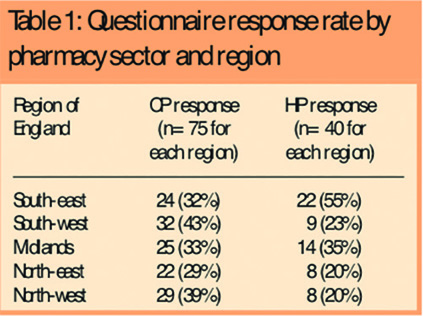
Pharmacists were asked to indicate how strongly they believed that a deliberate CBRN attack was likely to occur in the UK within the next five years. The results are shown in Table 2. About half (hospital pharmacists 55.7 per cent, community pharmacists 50.7 per cent) thought that an attack was likely or very likely.
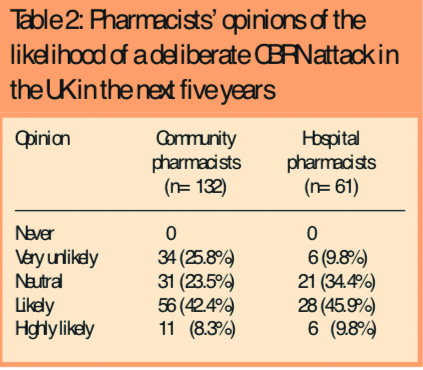
Respondents were then asked if they were aware of any plans to manage the results of a deliberate attack in the UK. Most pharmacists in each sector were not (hospital pharmacists 67.2 per cent, community pharmacists 74.2 per cent).
Respondents were asked to indicate if they were aware of any plans to involve pharmacists in the co-ordination of a response to a CBRN attack. Again, clear majorities said “no” (hospital pharmacists 88.5 per cent, community pharmacists 92.4 per cent).
Pharmacists were asked what roles they envisaged pharmacists playing in the event of an attack. A range of options was provided, with space to suggest other strategies (see Table 3).
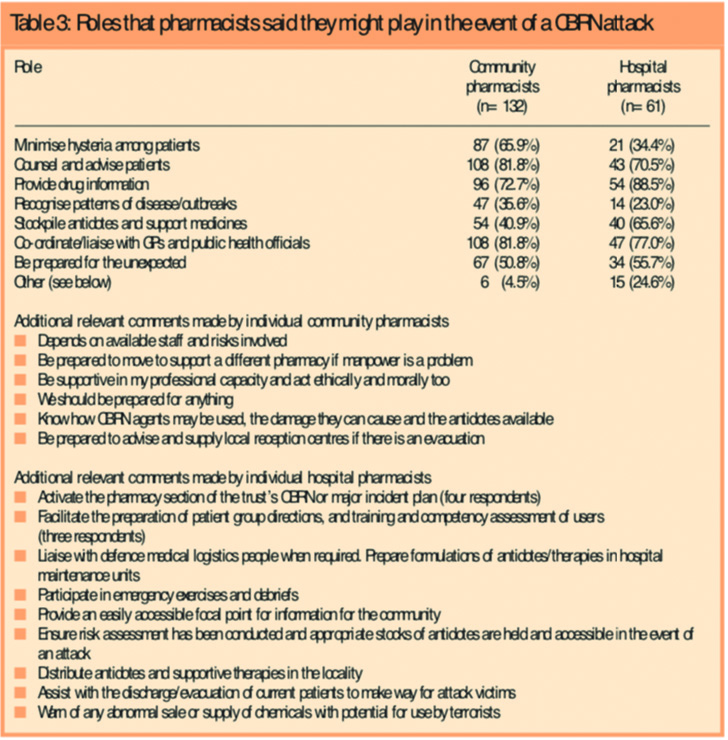
Respondents assessed their current ability to discriminate between a natural and a deliberate chemical, biological or radiological incident. Results are shown in Table 4. For all three scenarios, a high percentage of respondents (>65 per cent) rated their ability as limited or said they had no idea.

Pharmacists were then presented with a range of potential CBRN terrorism agents that had been derived from the literature7–9 and were asked to provide ratings of their own ability to recognise and manage an attack with each agent. Responses were expressed on a Likert scale of excellent, good, fair, limited and none for both recognition and management. For ease of analysis and presentation, replies of excellent and good were summated, as were replies of limited and none. Replies of fair were treated as the null point. The results are shown in Table 5 for microbiological agents and toxins and in Table 6 for chemical agents.
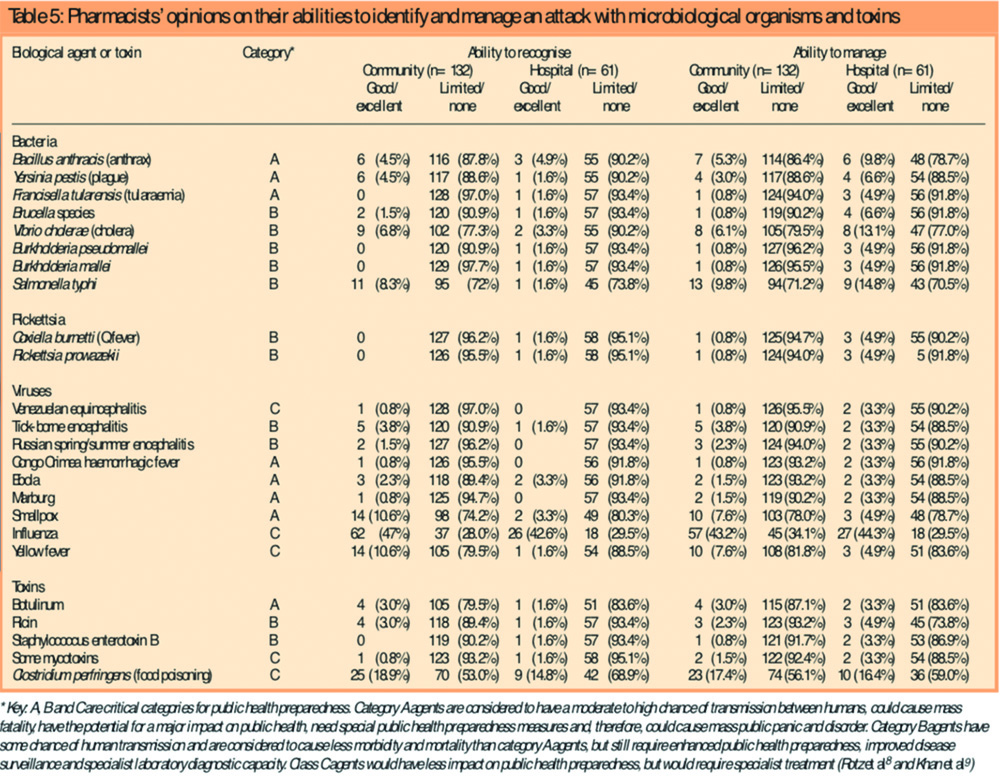
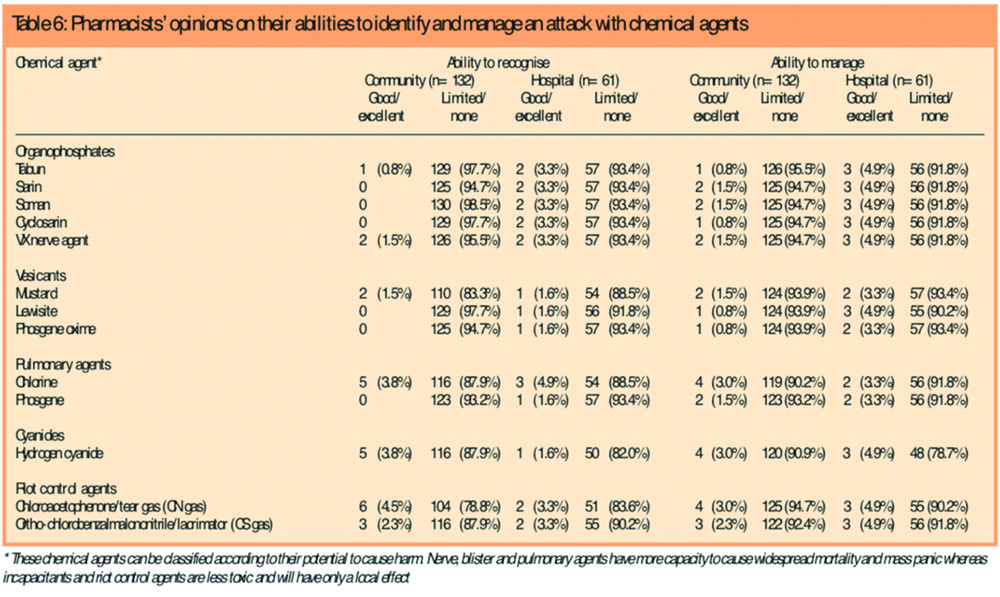
Pharmacists were then asked if they stocked or had access to any personal protective equipment in their workplace. For hospital pharmacists, 26 (42.6 per cent) said “yes”, 26 (42.6 per cent) said “no” and nine (14.8 per cent) said they did not know. Two community pharmacists (1.5 per cent) did not answer this question, 25 (18.9 per cent) said “yes” and 105 (79.5 per cent) said “no”.
Few respondents had received any teaching on CBRN as undergraduates (see Table 7).
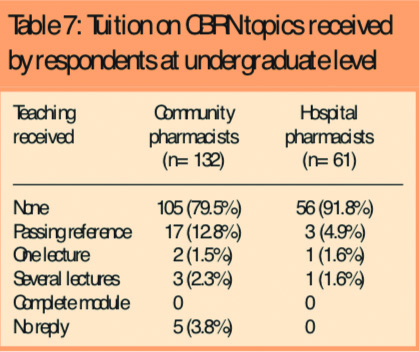
Several respondents mentioned that they had studied various agents in the context of microbiology or radiopharmacy, but that the emphasis was on epidemiology and treatment of disease rather than terrorism. Two (older) respondents remarked that there had been no need to cover potential terrorist threats with these agents when they read for their degrees. However, when asked if CBRN should now be taught as part of the MPharm degree, 46.2 per cent of hospital pharmacists and 54.5 per cent of community pharmacists agreed or strongly agreed. Few disagreed or strongly disagreed (11.5 per cent hospital pharmacists and 6.8 per cent of community pharmacists).
When asked if they would be interested in learning more about CBRN and related topics, 67.2 per cent of hospital pharmacists and 68.1 per cent of community pharmacists said that they would be interested or very interested. Pharmacists said they would like to receive the training in a variety of formats, shown in Table 8. Many respondents indicated that they would prefer a mixture of methods.
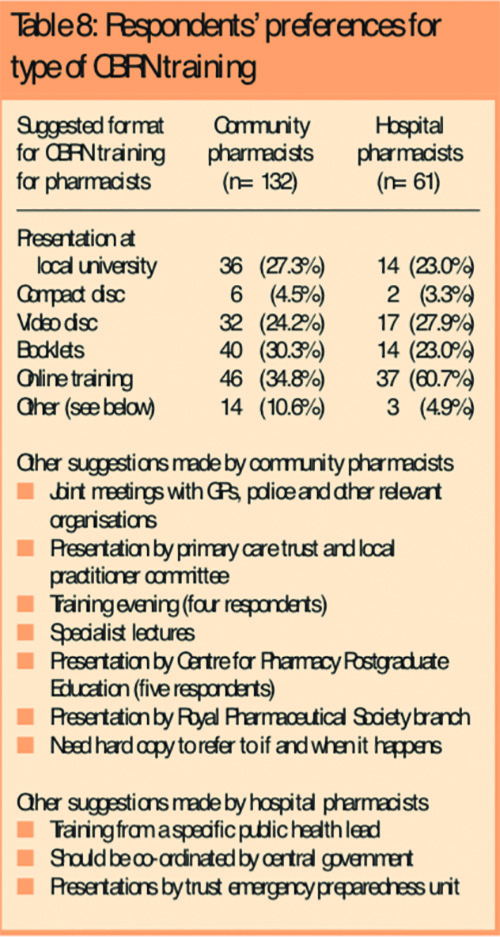
When asked if they had taken part in any CBRN training exercise organised by their local primary care trust or NHS trust, 55 hospital pharmacists (90.2 per cent) said “no” and six (9.8 per cent) said “yes”; 127 community pharmacists (96.2 per cent) said “no” and five (3.8 per cent) said “yes”. Of those community pharmacists who said “yes”, all five had done so in the past year; three hospital pharmacists had participated in the past year also. Training had taken the form of managing drug issues in reception centres (community); setting up a GP/pharmacist response unit (community); readying facilities and equipment in the accident and emergency department (hospital); and participating in tabletop exercises on mass immunisation against influenza or attack with chemical agents (four hospital pharmacists).
When asked if they had ever been sent any information from a Government department concerning CBRN, 108 community pharmacists (81.8 per cent) said they had not and 24 (18.2 per cent) said they had. The corresponding figures for hospital pharmacists were 39 (63.9 per cent) and 21 (34.4 per cent); one did not reply. The information had taken the form of written material (letters and booklets) for both sectors. Two community pharmacists remembered receiving a fax message when rumours of potential attacks with ricin were rife in January 2003.
When asked to identify the agency or ministry responsible for co-ordinating response to a CBRN attack in the UK, respondents chose a range of possibilities from a list and were allowed to add other suggestions, shown in Table 9. Almost half of the respondents said they did not know.
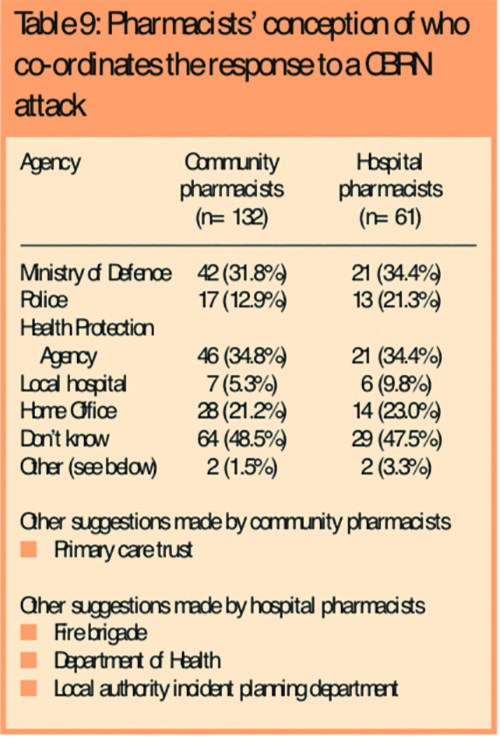
Thirty-four hospital pharmacists (55.7 per cent) and 70 (53.0 per cent) community pharmacists said that they would be interested in joining a UK equivalent of the US DMAT (see Discussion).
Discussion
This is the first study of its type to involve pharmacists. The respondent profile included a satisfactory mix of independent and multiple community pharmacy contractors and private, small district hospitals and large NHS teaching hospitals in each geographical area. It therefore allows one to gain a sense of the situation in the nation as a whole in the first quarter of 2007.
Over half the respondents considered a CBRN attack to be likely within the next five years, but most were unaware of plans to deal with an attack or if pharmacists were included in such plans.
In their own estimation, the abilities of pharmacists to distinguish between naturally occurring disease and the results of a CBRN attack were poor and they appeared to be unfamiliar with the recognition and management of disease caused by most of the potential biological agents listed.
For community pharmacists, the only agents for which ratings exceeded 10 per cent of respondents for recognition were smallpox, influenza, yellow fever and Clostridium perfringens food poisoning; for management, influenza was the only agent exceeding 10 per cent. For hospital pharmacists, the only two agents exceeding a recognition rating of 10 per cent were influenza and C perfringens. The highest management ratings were with Salmonella typhi infection, influenza and C perfringens.
It is not surprising that pharmacists said they were more familiar with these agents as they are likely to have met them when treating patients in practice. It is worrying that the abilities to recognise and manage infections with the most critical grade for public health preparedness were so low (Table 5). A similar analysis of data in Table 6 shows that none of the chemical agents listed reached a recognition or management rating of more than 10 per cent.
About half the respondents from both sectors believed that the topic should be included in the undergraduate curriculum and more than two-thirds said that they would be interested in learning more about CBRN-related topics. Cross-tabulation of data revealed that those who had participated in training had a better understanding of the recognition and management of biological and chemical agents than those who had not. For example, three of the four hospital pharmacists who rated their level of competence in recognising and managing symptoms as either good or excellent had taken part in tabletop exercises organised through their hospital trust.
More hospital pharmacists than community pharmacists had received Government information on CBRN issues but few could specify the topic. In addition, about half the respondents said they did not know what authority was responsible for co-ordinating a response to a CBRN attack and only 22 per cent correctly identified the Home Office.
Together, these data indicate a general disquiet about the official co-ordination of CBRN attack preparedness. It appears that this is not limited to pharmacists. Wong et al10 in 2006 conducted a telephone survey of senior doctors based in trauma units across the UK, asking them about their readiness to respond to a major terrorist incident. Almost half of the 144 respondents said they had not read any of their own hospital’s major incident plans and only just over half were clear about the specific role they would have, should such an emergency occur. Responses from major incident co-ordinators at 17 hospitals indicated that the frequency and timeliness of dry runs varied widely. A quarter of hospitals did not hold any teaching on major incident planning at their induction sessions for junior and middle grade doctors.
More than two-thirds of pharmacists said they would be interested in receiving training in CBRN countermeasures and more than half would be interested in playing a greater role. However, British pharmacists do not appear to be routinely offered any form of training in CBRN response. We believe that this should be addressed forthwith, perhaps by widening access to Health Protection Agency web-based training or the provision of specifically targeted material for pharmacists produced by the Centre for Pharmacy Postgraduate Education, which provides free courses for community pharmacists.
Andriopoulou et al7 indicate that, in the light of current threat levels, the training of healthcare professionals, including pharmacists, is a priority that should be addressed at European level as part of a long-term strategy. Several countries, including the UK, are participating in a joint European project to develop training materials to empower frontline health professionals to respond effectively to CBRN attacks.
Since the World Trade Centre attacks, the US has spent billions of dollars on CBRN countermeasures and American pharmacists appear to be fully involved in this strategy. They and their pharmacy technician colleagues are encouraged to join disaster medical assistance teams (DMATs), whose functions include triage of victims, provision of medical and pharmaceutical care and maintaining the clearance of casualties near disaster sites. Pharmacy emergency response teams (PERTs) have been set up in many areas to assist in disaster scenarios.11–14 Membership also entails completing both web-based and traditional training programmes. The pharmacist or technician is obliged to stay up to date with disease treatment guidance and recommendations, and be available to be deployed if needed.
Cohen15 provides a useful description of the formation of a PERT at a New York medical centre, to assist with management of CBRN terrorist threats. Key team members are a pharmacist co-ordinator, supported by a drug information pharmacist and clinical pharmacists in psychiatry, critical care, infectious diseases and radiopharmacy. The mission of the PERT is to maintain, prepare, mobilise, distribute and track a stockpile of designated pharmaceuticals (antidotes, antimicrobials, antitoxins, decontaminants and prophylaxis) and provide pharmaceutical information to help in the detection and treatment of patients exposed to CBRN agents. Emphasis is placed on training by drill and tabletop exercises and advanced training in disaster medicine for all team members.
Our study had shown that in England, such a level of organisation does not exist.
Conclusions
There is a need for training and education of pharmacists in CBRN countermeasures and it has been argued that the training of healthcare providers is the most important countermeasure that can be taken. This has been taken to heart in the US, where thousands of military and civilian healthcare providers have been educated through formal courses to recognise, raise the alarm and help treat cases of bioterrorism-related disease.
In the event of a CBRN attack in the UK, it is likely that casualties will present initially to hospital emergency departments. People who are still ambulant or who think they may have been exposed may also seek advice from their community pharmacist or GP. Community pharmacists and their hospital colleagues, particularly those working in accident and emergency or critical care environments, may well find themselves on the front line. Pharmacy must not be left out of these preparations as to do so would be to deprive the nation of a valuable and, from our study, willing resource.
For these reasons, it is important that all pharmacists should have sufficient training to recognise symptoms, to know how and when to refer and to provide effective pharmaceutical care to victims of an attack.
The UK has established an effective centre for postgraduate pharmacy education, providing free distance learning and evening courses on a wide range of pharmacy-related topics. We recommend that urgent consideration is given to providing a module on CBRN countermeasures as they relate to pharmaceutical care and the potential role of the pharmacist in the emergency healthcare team. In addition, there should be a greater effort in co-ordinating information on CBRN issues affecting the NHS and pharmacists should be widely circulated with information on the latest countermeasure thinking. Management within organisations should ensure that processes and procedures are properly documented, made readily available to pharmacists and are understood, implemented and maintained.
Pharmacists themselves should be encouraged by their professional body to conduct directed study in this area and relevant articles should be commissioned for publication in professional journals. Some thought should also be given to incorporating the basics of CBRN countermeasures into the undergraduate pharmacy curriculum.
Pharmacists with an interest in this area must be involved in emergency preparedness policy development and become role models for others.
Specific roles for pharmacists in taking CBRN countermeasures are shown in the Panel.
Panel: Specific roles for pharmacists in taking CBRN terrorism countermeasures
Specific roles for pharmacists in taking CBRN countermeasures include:
- Developing guidelines for diagnosis and treatment
- Involvement in drug therapy management
- Distribution of pharmaceuticals, from both hospital and community pharmacies
- Provision of advice to the public
- Ensuring the safe handling, storage, labelling and dispensing of emergency supplies
- Selecting pharmaceuticals for stockpiling
In all of these roles, there is much to learn from what has been achieved in the US, where the American Society for Health-system Pharmacists has taken a leading role in counter-terrorism and emergency planning.
Above all, as in the US, pharmacists in Britain appear to be willing to learn more about this topic and play a greater role in CBRN preparedness.
About the authors
David Brown, PhD, MRPharmS, is professor of pharmacy practice at the University of Portsmouth.
Patrick Doyle, BPharm, MRPharmS, is principal pharmacist at Royal Haslar Hospital, Gosport.
Roli Ojo, MPharm, was a pharmacy student at the University of Portsmouth.
Correspondence to: David Brown, School of Pharmacy and Biomedical Science, St Michael’s Building, White Swan Road, Portsmouth PO1 2DT (tel 023 9284 3590, fax 023 9284 3565, e-mail david.brown@port.ac.uk).
References
- Geissler E, van Courtland Moon JE. Biological and toxin weapons research. Development and use from the Middle Ages to 1945. SIPRI (Stockholm International Peace Research Institute) Chemical and Biological Warfare Studies No 18. Oxford: Oxford University Press, 1999.
- Tucker J. Assessing terrorist use of chemical and biological weapons. BCSIA Studies in International Security. Cambridge, Massachusetts: MIT Press, 2000.
- Miller J, Engelberg S, Broad W. Germs the ultimate weapon. New York: Simon & Schuster, 2001.
- Okumura T, Ninomiya, N, Ohta, M. The chemical disaster response system in Japan. Prehospital Disaster Medicine. 2003;18:189–92.
- Health Protection Agency. Clinical management of CBRN injuries. Cited 5/11/07. Available at: www.hpa.org.uk (accessed 5 November 2007).
- Binleys Online — Health and Care Information Specialist. Available at: www.binleysonline.com (accessed 12 November 2007).
- Andriopoulou A, Galatas I, Baka A, Kirch W, Fuchs A, Kyncl J et al. European training for health professionals on rapid response to health threats following biochemical terrorism incidents – the ETHREAT project. Available at: www.ethreat.info (accessed 12 November 2007).
- Rotz LD, Khan AS, Lillibridge SR, Ostroff SM, Hughes JM. Public health assessment of potential biological terrorism agents. Emerging Infectious Diseases 2002;8: 225–30.
- Khan AS, Stephen M, Lillibridge S. Public health preparedness for biological terrorism in the USA. Lancet 2000;356:1179–82.
- Wong K, Turner PS, Bopana A, Nugent Z, Coltman T, Cosker TDA et al. Preparation for the next major incident: are we ready? Emergency Medicine Journal 2006;23:709–12.
- American Society of Hospital Pharmacists. Emergency preparedness – counter terrorism. Available at: www.ashp.org/emergency/ background-journal.cfm (accessed 12 November 2007).
- Piscitelli SC. Response to bioterrorism and the pharmacist’s role. Address given at the American Pharmaceutical Association Annual Meeting (APhA 2000). Available at: www.medscape.com/viewarticle/419167 (accessed 30 June 2007).
- Pharmacy groups send letter to congress supporting pharmacy’s involvement in emergency preparedness and response. Available at: www.aphnet.org/ pharmcare/responseCenter.htm (accessed 30 June 2007).
- Knobler SL, Mahmoud AAF, Pray LA (eds). Biological threats and terrorism (electronic resource) Washington DC: National Academy Press, 2002.
- Cohen V. Organization of a health-system pharmacy team to respond to episodes of terrorism. American Journal of Health-System Pharmacy 2003; 60: 1257–63.

